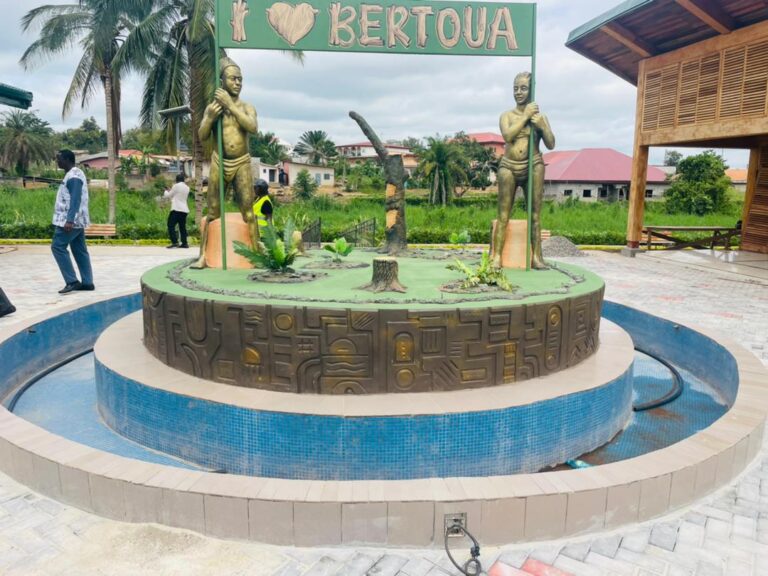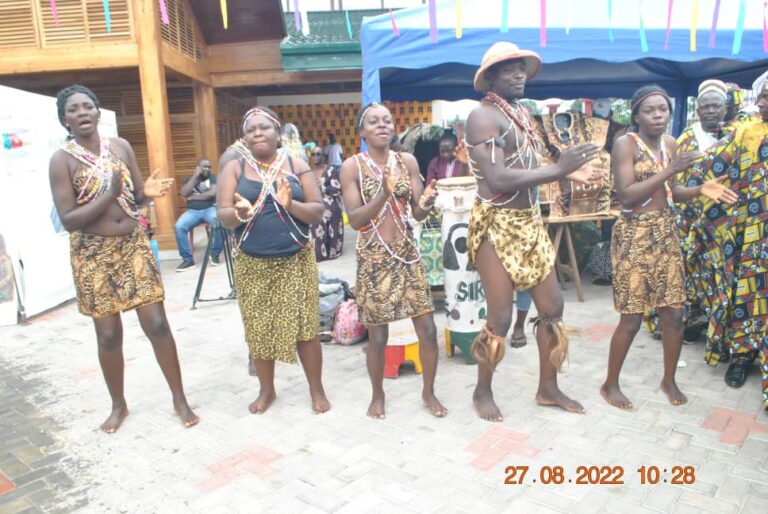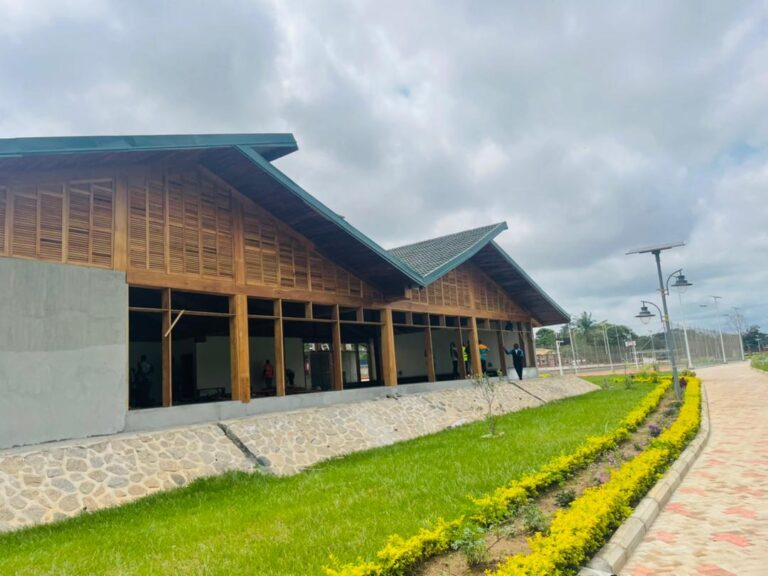Bertoua
Cameroon
PERSONAGES
The King of Mbartoua
The Gbaya are a group of Bantu in several African countries. Thanks to the many migratory movements, forced or not, that they have made over the years, they arrived in Cameroon in the eighteenth century. They settled down adapting to the environment and preserving their culture despite the influences it may have undergone.
In Cameroon, they are found in the East, more precisely in the localities of Bétaré-Oya and Bertoua. Their main activities are agriculture and gold mining in these two cities.
King Mbartoua (nickname given to him when he was because of his size and muscle mass), from his birth name 'GOH GOH NOU' (the panther of the earth) was born in the 1830s. After suffering immigration from Sudan and then from the Central African Republic, he settled in 'Bertoua', located in the eastern part of Cameroon.
According to oral sources, King Mbartoua was endowed with a Herculean strength that impressed by his size and build, and was also endowed with supernatural powers that allowed him to disappear. With an army composed of formidable warriors called 'SIRTA' and a large cavalry, he very quickly succeeded in conquering Bertoua and settling there, thus rejecting the first populations of the locality.
He fiercely opposed German penetration into the eastern region of Cameroon and after the death of Captain Hans, whose murder was attributed to him, King Mbartoua was driven out and took refuge in a cave located in the village Ngounté (a village located 15 km from the town of Bertoua).
Over time, this cave has become a place of pilgrimage for its descendants in particular and for the Gbaya people in general. The city of Bertoua owes its name to this mythical great king, and the settlers preferred the name Bertoua instead of Mbartoua.
The different kings who ruled over the canton of Gbaya are:
- King Ndiba
- King Abo
- King Labouro
- King Ngari (currently on the throne)
- King Ndiba
- King Abo
- King Labouro
- King Ngari (currently on the throne)
Glossary
''GOH GOH NOU'' = Real name of King Mbartoua meaning the panther of the earth.
SIRTA = the cavalry of King Mbartoua
Wèsé = Sun
Kórò = Rain
Gásá = Grand
SIRTA = the cavalry of King Mbartoua
Wèsé = Sun
Kórò = Rain
Gásá = Grand
WHAT TO EAT
Kam Couscous
The large human groups that populate the East Region of Cameroon are distributed according to the four departments that make it up, thus we have the Maka'a in the Department of Haut Nyon, the Gbaya who are in the majority in the Department of Lom and Djerem, the Kako'o in the Department of Kadey, and the Mpou-Mpong and Kounabembe in the Department of Boumba and Ngoko.
The main complement that accompanies all the dishes of the populations of Lom and Djerem and Kadey is 'kam' couscous: which is semolina made from cooked cassava tubers.
Ndenguéy
The populations of the Haut Nyong Department have as their main complement the "Ndenguéy": a mixture of cassava and plantain walls.
The plantain
The populations of the Boumba Department consume plantain much more as a complement that goes with all sauces.
MUST-SEE
The central mosque of Bertoua
The history of the central mosque of Bertoua is intimately linked to that of the arrival of the Muslim community in the said city in the 1900s. The Muslim community in the city of Bertoua is composed of the Hausa, Kanouri, Foulbé, Toupourie, Arab choa and Gbaya.
The first vestiges of the central mosque of Bertoua date back to 1965 and are made of temporary materials. It is located in the Mokolo I neighbourhood, at the former Residence of the Governors of the East Cameroon Region,
Later on, the central mosque was relocated to the "Briqueterie" in the "Marché historique" district.
During the construction of the German administrative services and the historic market, the central mosque was once again transferred to the "Haoussa quarter" with the help of the Gbaya Canton Chief, HAYE NDIBA (a fearless hunter whose lineage, Chief Haye, was quite simply the most emblematic and charismatic of the entire history of the Gbaya people of Bertoua), who worked on the granting of the site.
The first infrastructure in semi-hard materials (clay) of the central mosque of Bertoua dates back to 1975; thirty years later it underwent three modifications and the current architecture in permanent materials was built in the 2000s.
The central mosque of Bertoua has known to date 06 Imams classified in a chronological way.
- Malam Ousmanou
- Malam Hamadou
- Malam Hayatou
- Malam Oumarou
- Malam Ouseini
- Malam Oumarou (in office in 2022)
The administrative organisation sets the Chief of the Community above any other organisation and therefore gives him the power to appoint the Imam of the central mosque. We thus have a list of the different Chiefs who have led the Muslim community in the town of Bertoua.
- His Majesty Parka Sarky Babale
- His Majesty Aoudou Dama
- His Majesty Moustapha Dapari
- His Majesty Saliou Adama (in office since 28/08/1971)
- Malam Ousmanou
- Malam Hamadou
- Malam Hayatou
- Malam Oumarou
- Malam Ouseini
- Malam Oumarou (in office in 2022)
The administrative organisation sets the Chief of the Community above any other organisation and therefore gives him the power to appoint the Imam of the central mosque. We thus have a list of the different Chiefs who have led the Muslim community in the town of Bertoua.
- His Majesty Parka Sarky Babale
- His Majesty Aoudou Dama
- His Majesty Moustapha Dapari
- His Majesty Saliou Adama (in office since 28/08/1971)
The Cathedral of the Holy Family
The Diocese of Bertoua was created on 17 March 1983 following the dissolution of the Diocese of Doumé. The Cathedral of the Holy Family is not historically the first cathedral of this diocese. Before its construction, the diocese of Bertoua had as its cathedral the parish church of Christ the King of Nkolbikon, the first parish of the city of Bertoua, founded in 1942. The Cathedral of the Holy Family is built next to the parish church formerly known as Christ the Saviour, founded in 1961. The foundation stone of the Cathedral of the Holy Family was laid on 10 January 1993 by His Excellency Lambert Van Heygen, then first bishop and archbishop of Bertoua. It was built under the direction of the Reverend Father Fulco Marie, architect and priest of the Congregation of St. John. It was consecrated and inaugurated on 8 December 1996. At the time of its creation, the Cathedral of the Holy Family was run by the brothers of the community of St. John, but since July 2015, its management has been entrusted to the diocesan priests. It covers a territory formed by 8 living ecclesial communities (CEVs) that occupy the districts of Mokolo, Météo, Gaïmona, Elévage, Ndouan.
The Catholic Church in the city of Bertoua began its work of evangelization with the creation of the mission of Nkolbikon in 1942, then of Christ the Saviour, present seat of the Cathedral in 1961. The parishes of San Lorenzo de Tigaza and Saints Peter and Paul de Mokolo IV followed. Today the city of Bertoua has 24 parishes, a reception center, an interdiocesan major seminary, a Catholic hospital, 2 health centers, two secondary schools, a university, 9 primary schools, one for deaf and mute children.
Order of Succession of the Bishops of the Diocese of Bertoua
1) 17 March 1983: Bishop Lambert Van Heygen of Bertoua
2) 11 November 1994: Mons.Lambert Van Heygen, Archbishop of Bertoua
1) 17 March 1983: Bishop Lambert Van Heygen of Bertoua
2) 11 November 1994: Mons.Lambert Van Heygen, Archbishop of Bertoua
Sembe Lecco Park
The Sembe Lecco Park is a recreational area for entertainment and relaxation built by the Municipality of Bertoua with funding from the French Development Agency. It is located in Mokolo I.
It is called Sembe Lecco in homage to the first mayor of the city of Bertoua.
This park has handball courts, tennis courts, children’s playgrounds, a restaurant and a party room.
PICTURES

Sembe Lecco Park
Bertoua, Cameroon
Bendeke Yannick

Sirta Dance Group
Bertoua, Cameroon
Bendeke Yannick

Installation ceremony of a notable
Bertoua, Cameroon
Bendeke Yannick

First Mayor of Bertoua
Bertoua, Cameroon
Bendeke Yannick

Sirta Dance Group
Bertoua, Cameroon
Bendeke Yannick

Installation ceremony of a notable
Bertoua, Cameroon
Bendeke Yannick

Bertoua, Cameroon
Bendeke Yannick

Sirta Dance Group
Bertoua, Cameroon
Bendeke Yannick

Installation ceremony of a notable
Bertoua, Cameroon
Bendeke Yannick
Tagged cameroon
